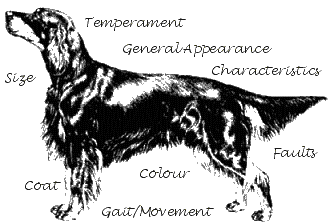Breed Standard
 |
The Gordon Setter is a unique dog and as such, has certain characteristics, which are unique to the breed.
|
Gordon Setter Breed Standard - ANKC (Dogs Australia).
GENERAL APPEARANCE - Stylish dog, with galloping lines. Consistent with its build which can be compared to a weight carrying hunter. Symmetrical in conformation throughout.
CHARACTERISTICS - Intelligent, able and dignified.
TEMPERAMENT - Bold, outgoing, of a kindly even disposition.
HEAD AND SKULL - Head deep rather than broad, but broader than muzzle, showing brain room. Skull slightly rounded, broadest between ears. Clearly defined stop, length from occiput to stop slightly longer than from stop to nose. Below and above eyes lean, cheeks as narrow as leanness of head allows. Muzzle fairly long with almost parallel lines, neither pointed, nor snipy. Flews not pendulous, clearly defined lips. Nose large, broad, nostrils open and black. Muzzle not quite as deep as its length.
EYES - Dark brown, bright. Neither deep nor prominent, set sufficiently under brows, showing keen, intelligent expression.
EARS - Medium size, thin. Set low, lying close to head.
MOUTH - Jaws strong with a perfect, regular and complete scissor bite, i.e. Upper teeth closely overlapping the lower teeth and set square to the jaws.
NECK - Long, lean, arched, without throatiness.
FOREQUARTERS - Shoulder blades long, sloping well back, wide flat bone, close at withers, not loaded. Elbows well let down, and close to body. Forelegs flat boned, straight, strong; upright pasterns.
BODY - Moderate length. Level topline, deep brisket, ribs well sprung. Back ribs deep. Loins wide, slightly arched. Chest not too broad.
HINDQUARTERS - From hip to hock long, broad and muscular, hock to heel short, strong, stifles well bent, straight from hock joint to ground. Pelvis tending to horizontal.
FEET - Oval, close knit, well arched toes, plenty of hair between. Well padded toes, deep heel cushions.
TAIL - Straight or slightly scimitar, not reaching below hocks. Carried horizontally or below line of back. Thick at root, tapering to fine point. Feather or flag starting near root, long straight, growing shorter to point.
GAIT/MOVEMENT - Steady, free moving and true, with plenty of drive behind.
COAT - On head, front of legs, tips of ears short and fine, moderate length, flat and free from curl or wave on all other parts of body. Feather on upper portion of ears long and silky, on backs of legs long, fine, flat and straight, fringes on belly may extend to chest and throat. As free as possible from curl or wave.
COLOUR - Deep shining coal black, without rustiness, with markings of chestnut red, i.e. lustrous tan. Black pencilling on toes and black streak under jaw permissible. 'Tan markings': two clear spots over eyes not over three-quarters of an inch in diameter. On sides of muzzle, tan not reaching above base of nose, resembling a stripe around clearly defined end of muzzle from one side to other. Also on throat, two large, clear spots on chest. On inside hindlegs and inside thighs, showing down front of stifle and broadening out to outside of hindlegs from hock to toes. On forelegs, up to elbows behind, and to knees or little above, in front. Around vent. Very small white spot on chest permissible. No other colour permissible.
SIZE -
Height: Dogs 66 cms (26 ins)
Bitches 62 cms (24 & 1/2 ins)
Weight: Dogs 29 & 1/2 kgs (65 lbs)
Bitches 25 & 1/2 kgs (56 lbs)
FAULTS - Any departure from the foregoing points should be considered a fault and the seriousness with which the fault should be regarded should be in exact proportion to its degree.
NOTE - Male animals should have two apparently normal testicles fully descended into the scrotum.
Contact Details
Steve Bennett & Sarah Auld-under constructionAdelaide Hills, SA, Australia
Phone : Steve 0414930223 Sarah 0407653697
Email : [email protected]
